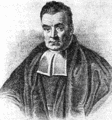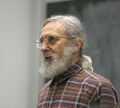Template:Selected anniversaries/April 7: Difference between revisions
No edit summary |
No edit summary |
||
| Line 38: | Line 38: | ||
File:Paul Du Bois-Reymond Heidelberg.jpg|link=Paul du Bois-Reymond (nonfiction)|1889: Mathematician [[Paul du Bois-Reymond (nonfiction)|Paul David Gustav du Bois-Reymond]] dies. He worked on the theory of functions and in mathematical physics. | File:Paul Du Bois-Reymond Heidelberg.jpg|link=Paul du Bois-Reymond (nonfiction)|1889: Mathematician [[Paul du Bois-Reymond (nonfiction)|Paul David Gustav du Bois-Reymond]] dies. He worked on the theory of functions and in mathematical physics. | ||
||1894: Louis Plack Hammett born ... physical chemist. He is known for the Hammett equation, which relates reaction rates to equilibrium constants for certain classes of organic reactions involving substituted aromatic compounds. He is also known for his research into superacids and his development of a scheme for comparing their acidities based on what is now known as the Hammett acidity function. Pic search | ||1891: Caroonist David Low born ... political cartoonist and caricaturist who lived and worked in the United Kingdom for many years. Low was a self-taught cartoonist. Born in New Zealand, he worked in his native country before migrating to Sydney in 1911, and ultimately to London (1919), where he made his career and earned fame for his Colonel Blimp depictions and his merciless satirising of the personalities and policies of German dictator Adolf Hitler, Italian dictator Benito Mussolini, Soviet dictator Joseph Stalin, and other leaders of his times. Pic. | ||
||1894: Louis Plack Hammett born ... physical chemist. He is known for the Hammett equation, which relates reaction rates to equilibrium constants for certain classes of organic reactions involving substituted aromatic compounds. He is also known for his research into superacids and his development of a scheme for comparing their acidities based on what is now known as the Hammett acidity function. Pic search. | |||
File:Pieter Rijke.jpg|link=Pieter Rijke (nonfiction)|1899: Physicist and academic [[Pieter Rijke (nonfiction)|Petrus Leonardus Rijke]] dies. He explored the physics of electricity, and is known for the Rijke tube (which turns heat into sound, by creating a self-amplifying standing wave). | File:Pieter Rijke.jpg|link=Pieter Rijke (nonfiction)|1899: Physicist and academic [[Pieter Rijke (nonfiction)|Petrus Leonardus Rijke]] dies. He explored the physics of electricity, and is known for the Rijke tube (which turns heat into sound, by creating a self-amplifying standing wave). | ||
| Line 46: | Line 48: | ||
||1914: Heinz Billing born ... physicist and computer scientist, widely considered a pioneer in the construction of computer systems and computer data storage, who built a prototype laser interferometric gravitational wave detector. Pic. | ||1914: Heinz Billing born ... physicist and computer scientist, widely considered a pioneer in the construction of computer systems and computer data storage, who built a prototype laser interferometric gravitational wave detector. Pic. | ||
||1921: Feza Gürsey born ... mathematician and physicist. Pic search | ||1921: Feza Gürsey born ... mathematician and physicist. Pic search. | ||
||1927: The first long-distance public television broadcast (from Washington, D.C., to New York City, displaying the image of Commerce Secretary Herbert Hoover). | ||1927: The first long-distance public television broadcast (from Washington, D.C., to New York City, displaying the image of Commerce Secretary Herbert Hoover). | ||
Revision as of 16:06, 22 April 2020
1761: Mathematician, philosopher, and minister Thomas Bayes dies. He is remembered for having formulated a specific case of the theorem that bears his name: Bayes' theorem.
1788: Mathematician and APTO field engineer Louis François Antoine Arbogast defeats the Forbidden Ratio in single combat by separating the symbols of operation from those of quantity.
1811: Astronomer, mathematician, and philosopher Hasan Tahsini born. He will become one of the most prominent scholars of the Ottoman Empire of the 19th century.
1860: Physicist and crime-fighter Ernst Ruhmer invents a camera which uses the light-sensitivity properties of selenium to record images from past and future events. This type of camera is popular with math photographers, notably Cantor Parabola.
1866: Mathematician Erik Ivar Fredholm born. He will introduce and analyze a class of integral equations now called Fredholm equations. Fredholm's work on integral equations and operator theory will anticipate the theory of Hilbert spaces.
1867: Gem detective Niles Cartouchian works with Hasan Tahsini to recover stolen shipment of time crystals (nonfiction).
1889: Mathematician Paul David Gustav du Bois-Reymond dies. He worked on the theory of functions and in mathematical physics.
1899: Physicist and academic Petrus Leonardus Rijke dies. He explored the physics of electricity, and is known for the Rijke tube (which turns heat into sound, by creating a self-amplifying standing wave).
1903: United States Navy Admiral Edwin Thomas Layton born. Layton will serve as a Naval intelligence officer before and during World War II.
2014: Mathematician and academic Tim Cochran born. He will contribute to topology, especially low-dimensional topology, the theory of knots and links and associated algebra.
1995: Mathematician and crime-fighter Donald Erik Sarason combines Hardy space theory with Vanishing mean oscillation (VMO); in the process, he will discover radical new techniques for detecting and preventing crimes against mathematical constants.
1995: Math photographer Cantor Parabola takes a series of photographs which capture temporal superimpositions from physicist and academic Petrus Leonardus Rijke in the form of a self-amplifying standing wave.
2009: Game designer Dave Arneson dies. He co-created the pioneering role-playing game Dungeons & Dragons with Gary Gygax.











